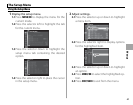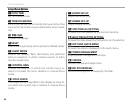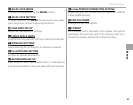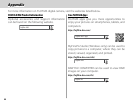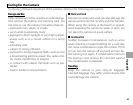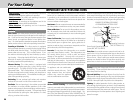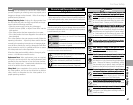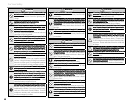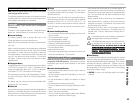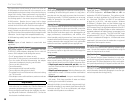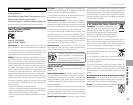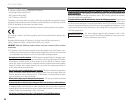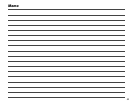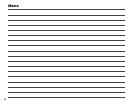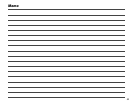
49
For Your Safety
For Your Safety
The Battery and Power Supply
Note: Check the type of battery used in your camera and
read the appropriate sections.
The following describes the proper use of batteries and how
to prolong their life. Incorrect use can shorten battery life or
cause leakage, overheating, fi re, or explosion.
Li-ion Batteries
Li-ion Batteries
Read this section if your camera uses a rechargeable
Li-ion battery.
The battery is not charged at shipment. Charge the battery
before use. Keep the battery in its case when not in use.
■Notes on the Battery
The battery gradually loses its charge when not in use.
Charge the battery one or two days before use.
Battery life can be extended by turning the camera off when
not in use.
Battery capacity decreases at low temperatures; a depleted
battery may not function at when cold. Keep a fully charged
spare battery in a warm place and exchange as necessary,
or keep the battery in your pocket or other warm place and
insert it in the camera only when shooting. Do not place
the battery in direct contact with hand warmers or other
heating devices.
■ Charging the Battery
Charging times will increase at ambient temperatures below
+10 °C (+50 °F) or above +35 °C (+95 °F). The battery will not
charge at temperatures above 40 °C (+104 °F); at tempera-
tures below 0 °C (+32 °F), the battery will not charge.
Do not attempt to recharge a fully charged battery. The bat-
tery does not however need to be fully discharged before
charging.
The battery may be warm to the touch immediately after
charging or use. This is normal.
■Battery Life
At normal temperatures, the battery can be recharged about
300 times. A noticeable decrease in the length of time the
battery will hold a charge indicates that it has reached the
end of its service life and should be replaced.
■Storage
Performance may be impaired if the battery is left unused
for extended periods when fully charged. Run the battery
fl at before storing it.
If the camera will not be used for an extended period, re-
move the battery and store it in a dry place with an ambient
temperature of from +15 °C to +25 °C (+59 °F to +77 °F). Do
not store in locations where moisture could be present or
where the battery could be exposed to extremes of tem-
perature.
■Cautions: Handling the Battery
• Do not transport or store with metal objects such as neck-
laces or hairpins.
• Do not expose to fl ame or heat.
• Do not disassemble or modify.
• Use with designated chargers only.
• Dispose of used batteries promptly.
• Do not drop or subject to strong physical shocks.
• Do not expose to water.
• Keep the terminals clean.
• The battery and camera body may become warm to the
touch after extended use. This is normal.
AA Alkaline/Rechargeable Ni-MH Batteries
AA Alkaline/Rechargeable Ni-MH Batteries
Read this section if your camera uses AA alkaline or re-
chargeable AA Ni-MH batteries. Information on compat-
ible battery types may be found elsewhere in the camera
manual.
■Cautions: Handling the Batteries
• Do not expose to water, fl ame, or heat, or store in warm or
humid conditions.
• Do not transport or store with metal objects such as neck-
laces or hairpins.
• Do not disassemble or modify the batteries or battery
casing.
• Do not subject to strong physical shocks.
• Do not use batteries that are leaking, deformed, or discol-
ored.
• Keep out of reach of infants and small children.
• Insert in the correct orientation.
• Do not mix old and new batteries, batteries with diff erent
charge levels, or batteries of diff erent types.
• If the camera will not be used for an extended period, re-
move the batteries. Note that the camera clock will be reset.
• The batteries may be warm to the touch immediately after
use. Turn the camera off and allow the batteries to cool
before handling.
• Battery capacity tends to decrease at low temperatures.
Keep spare batteries in a pocket or other warm place and
exchange as necessary. Cold batteries may recover some
of their charge when warmed.
• Fingerprints and other stains on the battery terminals
can impair battery performance. Thoroughly clean the
terminals with a soft, dry cloth before inserting them in
the camera.
If the batteries leak, clean the battery compartment
thoroughly before inserting new batteries.
If fl uid from the battery comes into contact with skin
or clothing, fl ush the aff ected area with water.
If
If
uid enters your eyes, immediately ush the a ected
uid enters your eyes, immediately ush the a ected
area with water and seek medical attention.
area with water and seek medical attention.
Do not rub
Do not rub
your eyes.
your eyes.
Failure to observe this precaution could result
Failure to observe this precaution could result
in permanent visual impairment
in permanent visual impairment.
■Ni-MH Batteries
The capacity of Ni-MH batteries may be temporarily reduced
when new, after long periods of disuse, or if they are repeat-
edly recharged before being fully discharged. This is normal
and does not indicate a malfunction. Capacity can be in-
creased by repeatedly discharging the batteries using the
discharge option in the camera setup menu and recharging
them using a battery charger.
QCAUTION: Do not use the discharge option with alkaline
batteries.



